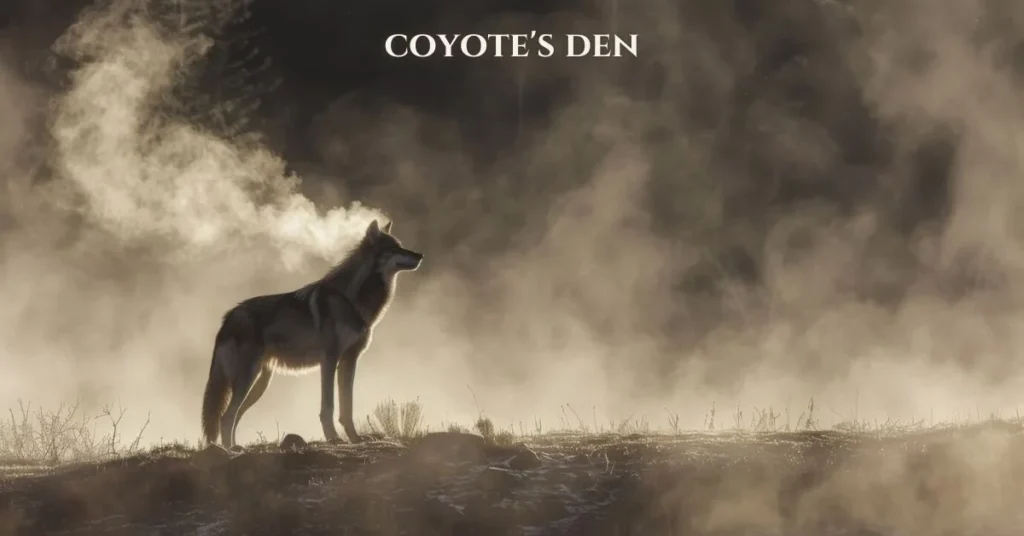Introduction
Have you ever wondered what goes on behind the hidden entrances in the wild where coyotes make their homes? Coyote dens aren’t just holes in the ground—they are sophisticated, protective refuges where these resourceful canids raise their families and weather the challenges of their diverse habitats. In this article, we’ll take an in-depth look into everything about the coyote’s den, exploring its anatomy, history, cultural significance, ecological role, and even the interactions between these versatile animals and human development. Grab a cup of coffee and settle in as we uncover some fascinating insights into one of nature’s most resilient shelters.
Definition and Overview of a Coyote’s Den
At its simplest, a coyote’s den is a shelter dug into the ground, nestled in natural areas such as sandy banks, rocky outcrops, or under fallen trees. These dens serve as a secure space for breeding, raising pups, and resting during extreme weather. While many of us might imagine a den as a fixed structure, coyotes are incredibly adaptable—they often shift locations based on seasonal needs and safety concerns. Imagine a multi-room underground apartment that is modified depending on weather conditions and family needs; that’s essentially what a coyote’s den can be.
The Role of Dens in Coyote Survival
For coyotes, a den is more than just a shelter. It acts as a life-support system: a protected breeding ground, a safe haven for young pups, and a refuge during the harsh conditions of winter or the sweltering heat of summer. Using these dens, coyotes can hide from larger predators and even from human disturbances. This adaptability is key to their survival, allowing them to thrive in both wild landscapes and urban settings.
Historical and Cultural Background
Coyotes have had a profound influence on various cultures throughout history. Their behavior, cunning, and survival instincts have made them intriguing subjects of myths and legends, especially among Native American communities.
Native American Legends and Coyote Mythology
In many Native American traditions, the coyote is a trickster, a creator, and sometimes even a teacher. Often portrayed as both a hero and a mischievous figure, the coyote holds a significant place in folklore. The den, as the home of the coyote, is viewed not only as a physical shelter but also as a symbolic space where the mysteries of nature converge. These stories have been passed down through generations, imbuing the coyote and its den with layers of myth and respect.
Folklore and Artistic Representations
Beyond indigenous cultures, the image of the coyote has seeped into broader folklore and art. Writers, filmmakers, and artists have drawn on the symbolism of the den to create narratives rich with metaphors about refuge, transformation, and survival. When you see references to the “coyote’s den” in literature, think of it as a metaphor for any place where one finds solace or hidden wisdom.
Anatomy of a Coyote’s Den
Understanding the physical structure of a coyote’s den gives us a glimpse into how nature ingeniously adapts to its environment. These dens are often a marvel of natural engineering.
Structure and Design
A typical coyote den is an interconnected network of tunnels and chambers, often with multiple entry and exit points to allow for effective escape routes. The primary design centers on safety and functionality. Coyotes tend to choose locations that provide natural camouflage—a hillside covered in vegetation or a secluded area under a rocky overhang, for instance. This strategic design helps in evading predators and ensuring the pups are kept away from direct exposure to dangers.
Materials and Construction Techniques
Coyotes are not exactly known for using modern construction materials, but they exhibit impressive natural engineering skills. They rely on their strong forelimbs and agile bodies to excavate dirt, sand, or soft rock. Over time, repeated use can lead to the expansion of these dens, where natural elements play a significant role.
Natural Environment Contributions
The surrounding natural environment is key to the durability of a coyote’s den. Loose soil, existing natural holes, and even fallen debris can all contribute to the den’s structure. The ability of coyotes to modify and enhance these natural features has allowed them to create a comfortable living space that maintains a regulated temperature, a crucial factor for rearing young pups.
Habitats and Distribution
Coyotes have an incredible adaptability that makes their dens as common in wild landscapes as they are in the outskirts of urban areas. Their versatility has made them one of the most widespread carnivores in North America.
Coyote Dens in Rural Areas
In rural settings, coyote dens are typically found in open fields, along the edges of woodlands, or near water sources. These locations provide abundant prey and plenty of cover. With fewer human interferences, rural dens tend to be more stable over time. Here, the den isn’t just a place to sleep; it’s a hub of activity where a whole family group might engage in communal care and hunting strategies.
Urban Adaptations and Coexistence
The expansion of urban areas has pushed coyotes to adapt uniquely to a new environment. Urban coyote dens can sometimes be found in parks, near abandoned buildings, or in industrial areas where there’s less human traffic during certain hours. Despite potential conflicts, these urban adaptations illustrate the coyote’s resilience. As residents, it’s important to understand that these creatures are simply using the spaces available to survive, which in many cases are remnants of once-wild landscapes that now border our cities.
Behavioral Aspects Inside the Den
The den is where the intimate, often hidden side of coyote life unfolds. It is within these burrows that family bonds are formed and life lessons are passed down.
Breeding and Rearing Pups
Coyotes typically use their dens for breeding and nurturing their young. The female coyote, or “bitch,” usually gives birth in a secure and concealed portion of the den. The initial weeks and months are critical; the dens provide warmth, shelter, and security essential for the development of the pups. Early in life, the pups rely entirely on their parents and any helper coyotes for sustenance and protection.
Challenges Facing Pups
The first few weeks after birth are fraught with challenges—temperature fluctuations, potential predatory threats, and competition for resources among siblings. Coyotes are well aware of these challenges, which is why their dens are chosen strategically to minimize such risks. Parents teach their pups survival skills, a process that occurs mostly within the safe confines of the den before the youngsters venture out on their own.
Social Hierarchy and Communication
Communication is a vital aspect of life in the den. Coyotes use a range of vocalizations, body language, and scent markings to establish and maintain their social structure. Their interactions are not only about establishing dominance but also about nurturing bonds and ensuring cooperative behaviors within the family group.
Social Learning and Group Dynamics
Within the den, young coyotes absorb important life lessons from the adults. This social learning includes recognizing danger signals, hunting strategies, and even the subtleties of communicating with other members of their pack. Think of it as a kind of “coyote school” where every sound, gesture, or behavior is a lesson in survival.
Ecological Importance of Coyote Dens
Coyote dens do more than provide a safe haven for these animals—they also play a significant role in their ecosystems.
Impact on Local Ecosystems
By serving as a base for territorial and hunting activities, coyote dens contribute to local biodiversity. Coyotes help control populations of small mammals and rodents, which can have downstream effects on agricultural crops and even the balance of other predators. Their dens, by extension, are an integral element of ecological balance.
Coyote Role in Population Control
Coyotes are often referred to as nature’s pest controllers. By preying on rodents and other small mammals that can harm crops and spread disease, they help maintain a healthy ecosystem. This predatory balance prevents overpopulation of any one species, thereby ensuring that the habitat remains diverse and robust. Their dens serve as the operational headquarters for these vital ecological activities.
Human Impact and Conservation Efforts
As urban sprawl continues to expand, the encounter between humans and coyote dens becomes more frequent. This intersection of nature and urban development has both challenges and opportunities.
Threats from Urban Expansion
One of the biggest threats to coyote dens is encroachment by urban development. As natural habitats shrink, dens are often disturbed or even destroyed. This loss can force coyotes into even more precarious situations, where they must balance survival instincts with potential conflicts with humans. Awareness and careful planning are essential to minimize such negative impacts.
Strategies for Coexistence
Many communities are learning to live with coyotes instead of viewing them as nuisances. Coexistence strategies include proper waste management to reduce the allure of urban areas, educational campaigns on how to avoid conflicts, and designated wildlife corridors that allow safe transit for these animals. By adopting a proactive approach, it is possible to safeguard both human interests and the natural behavior of coyotes.
Modern Perspectives and Misconceptions
Modern media and scientific research continue to shape our understanding of coyotes and their dens. Sometimes, the portrayal in the media diverges considerably from the scientific reality, leading to common misconceptions.
Media Portrayals and Public Perception
Often depicted as cunning villains or aggressive pests, coyotes are sometimes unfairly maligned by sensational headlines and urban legends. The reality is much more nuanced. Their dens, often viewed through the lens of fear or misunderstanding, are actually centers of life and survival. With balanced reporting and increased awareness, public perception is slowly evolving to embrace the ecological significance of these creatures.
Scientific Studies and Discoveries
Ongoing research is shedding light on the intricate lives of coyotes. Field studies have revealed surprising details—from the complexity of their social structures to the adaptive nature of their dens. Scientists employ modern tracking methods and environmental monitoring to better understand how these animals adapt to changing landscapes. This scientific insight helps us develop better conservation policies and encourages a more empathetic perspective towards wildlife living near urban regions.
Conclusion
The coyote’s den is far more than a simple hole in the ground; it is a dynamic and vital space that underpins the survival of one of North America’s most adaptable carnivores. From its structural ingenuity and cultural significance in indigenous traditions to its critical role in ecosystem balance and modern urban survival strategies, every facet of the den reveals a story of resilience, adaptation, and natural beauty. By understanding and respecting these natural havens, we not only gain insight into the secret lives of coyotes but also learn valuable lessons about coexistence and the intricacies of the natural world.
Modern science continues to unravel the layers of mystery surrounding coyote dens, transforming outdated myths into compelling narratives of survival and ecological harmony. Ultimately, whether nestled under a rural hillside or hidden behind urban structures, the coyote’s den remains a symbol of nature’s enduring spirit—an ever-evolving reminder of the importance of adaptation in the face of change.
FAQs
What makes a coyote’s den unique compared to other animal shelters?
A coyote’s den is unique due to its adaptive structure—a network of tunnels designed not only for protection and breeding but also for regulating temperature and providing multiple escape routes, making it a dynamic living space.
How do coyotes choose the location for their dens?
Coyotes select den sites based on safety, availability of food, and shelter from predators. They often opt for locations with natural camouflage such as hillsides, rocky outcrops, or dense vegetation that provides both cover and thermal stability.
Are urban areas safe for coyotes, and how do their dens adapt to city life?
While urban environments pose challenges, coyotes have proven remarkably adaptable. They often find dens in less disturbed areas like parks or near abandoned structures. Coexistence strategies by communities help ensure that both humans and coyotes can coexist safely.
What role do coyote dens play in the ecosystem?
Coyote dens are crucial not just for the animals themselves but for the whole ecosystem. By serving as bases for territorial behavior and hunting, they help control rodent and small mammal populations, contributing to overall ecological balance.
How can we better support the conservation of coyotes and their natural habitats?
Supporting conservation efforts involves responsible urban planning, preserving natural habitats, and increasing public awareness about the ecological roles of coyotes. Educational initiatives and wildlife corridors also play an essential role in facilitating coexistence.






